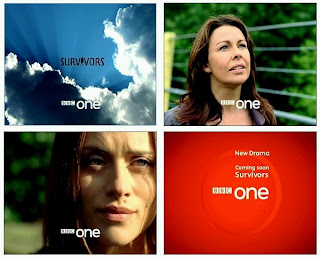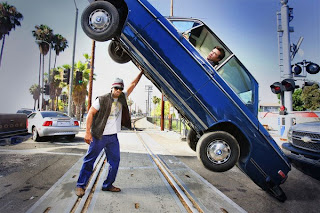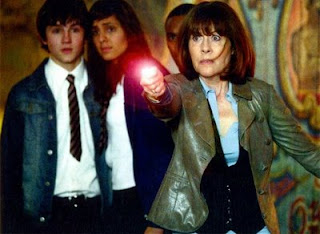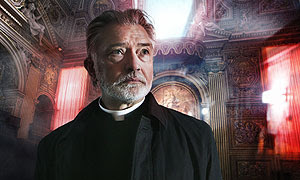
Incredibly, it’s now three years since the BBC broadcast its first 'Dr Who’ Christmas Special, a primetime treat quickly commissioned when the critical and public success of the first Russell T Davies-powered series in 2005 became pretty much inarguable. The BBC, desperate for a new ‘Only Fools and Horses’ or even a new ‘Morecombe and Wise Show’ around which to build their Christmas Night TV schedules, suspected that the family-friendly adventures of the Doctor and his chums might just become the new must-watch TV show for the one night of the year when the whole family is pretty much guaranteed to be sitting down in one room watching the same television. The Beeb’s instincts were pretty much right and the viewing figures seem to show that the annual ‘Dr Who’ Christmas episode has now cemented itself as an institution in much the way the series itself has generally.
But ‘Dr Who’ at Christmas is a curious beast. Russell T Davies himself writes the thing and he ahs very distinct, specific ideas about what makes a Good Christmas TV Special. It’s got to be Christmassy – so we get Christmas decorations, snow, trees and plenty of festive good cheer. But because it’s Christmas we also get compromises; we get a show which sets out, whatever the story, to be fun. Christmas is no time for a fiddly concept story like ‘Blink’ or ‘Midnight’, nor is it time for something head-scratching like ‘Silence in the Library’ or innovative like ‘Love and Monsters’. Davies crafts his Christmas specials very specifically; they’re big, brash, loud, desperately unsubtle and generally leave you feeling a bit breathless. There’s also a sense, in certain areas of fandom where expectation always outweighs reality (in every sense of the word) and no matter how many romping Christmas ‘Dr Who’ episodes are wheeled out, some fans always expect that this one will be different, this one will be more like the series itself. But the fact is that ‘Dr Who’ at Christmas isn’t meant to go deep, it’s not meant to be a huge high-concept science-fiction mind-boggler; it’s flagship Christmas TV, it almost always has a big USP (a new Doctor! Catherine Tate!! Kylie!!! The Next Doctor???) and it’s meant to be fun for all the family, a family invariably bloated on turkey, mince pies, chocolates and one too many of those little bottles of lager. You’re supposed to just watch it and enjoy it without straining your grey cells too much. Just sit back and go along for the ride. Normal service will be resumed…well, at Easter in this case.
So here we are with ‘The Next Doctor’ and, with viewing figures touching 12 million, it looks like Davies had done it again and created an hour of TV which did what it set out to do – it pulled in a huge audience (50% of the TV audience) and it left them thoroughly entertained. How couldn’t it? The story’s pre-publicity carefully built on the rumblings which have grown since David Tennant’s teary NTA announcement that he won’t be back after 2009’s run of special episodes – Who Will Be The Next Doctor? The strategically-placed broadcast of the first two minutes of this Christmas episode in November’s ‘Children in Need’ and the revelation that its title was ‘The Next Doctor’ managed to make this episode just about unmissable to anyone with even a passing interest in the show and its mythology. David Morrissey!! He’s the next Doctor, then…except, as it turns out, no he isn’t…
The Doctor pitches up in Victorian London on Christmas Eve. Within seconds he meets up with a striking frock-coated fellow who claims that he’s “the Doctor” and soon the pair – and the nw boy’s fetching assistant Rosita – are battling hostile Cybermen clanking through the snow and the machinations of the sinister Miss Mercy Hartigan. At first the Doctor – our Doctor – can only conclude that he’s stumbled upon a future incarnation of himself and it’s rather startling to watch David Tennant portraying a man who suddenly has to face up to the inevitability of his regeneration, a moment which may be sooner than he’s thought. But as the story rolls on and the Doctor stumbles across some Cybertechnology, our boy realises the tragic truth…

Unlike previous Christmas episodes ‘The Next Doctor’ has more to hang its hat on than just its guest star. Here there’s a mystery; who is this man who really seems to be the Doctor? Why has he lost his memory? And why on Earth is his TARDIS a grounded hot-air balloon?? This is what draws the audience in and keeps them in; the antics of the Cybermen are just a bit of silver icing on already rich cake. And it’s the two Doctors – our Doctor and the new Doctor who turns out to be a man called Jackson Lake - which really makes ‘The Next Doctor’ more than just a Christmas ‘Dr Who’ romp. Because even though the episode, because it’s Christmas, has to have a CGI-powered climax and lots of bangs and flashes, what really makes the episode tick and what makes it work are those moments of humanity between two men, one of whom isn’t even human.
Jackson Lake (Morrissey) is a man who has lost his memory because of a terrible trauma on arriving in London with his family to take up a new job. An encounter with skulking Cybermen caused the death of his wife and the abduction of his young son. But Jackson remembers none of this; an encounter with a piece of Cyberkit has chased away his own memories and replaced them with the stored knowledge of the Cybermen of a man who has confounded them again and again – the Doctor. Jackson Lake believes he is the Doctor because his mind is filled with Cyberknowledge of the Doctor. Being the Doctor is all he knows. This is tragic and the unravelling of the ‘mystery’ is what makes ‘The Next Doctor’ so compelling. Morrissey plays Lake’s torment beautifully and Tennant, as usual, ticks all the boxes we’ve come to expect of him and then some. Because here and now we have a slightly-different tenth Doctor. Recent events have been too much for him and he’s now travelling alone – his admission at the end of the episode that his friends always end up ‘breaking my heart’ is gut-wrenching. Earlier on the Doctor has had to face up to the very real prospect of his own ‘lie’ ending and there’s a wistful acceptance of it in the Doctor’s behaviour and in Tennant’s powered performance.
This is what lies at the heart of ‘The Next Doctor’ – the agony of Jackson Lake and the tragedy-to-come of the tenth Doctor. This is what resonates with me as an avowed fan of the new touchy-feely style of ‘Dr Who’ – the new show’s at its very best when it’s opening up its hero so we can see what makes him tick. And here we see a raw, emotionally-damaged man who is, we can see, at a crossroads and moving towards a time of change. As, indeed, is the programme…
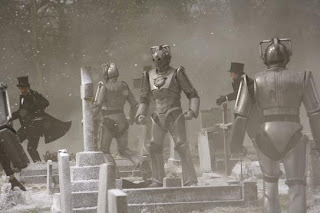
What brings these two great men together, of course, is a very familiar and very deadly threat. The Cybermen have turned up in Victorian London – they look like the Cybus Cybermen from the new series mythology and yet they seem to know a bit about the history of the Doctor so they may well be ‘old school’ Cybermen, the script’s a bit vague on that one – and they’re in league with Miss Hartigan for their own sinister purposes. She wants to use the Cybermen to start “a new Industrial Revolution” with her at its head; the Cybermen, duplicitous as ever, want to use her to power their giant Cyberdreadnaught hidden beneath the Thames. The Cybermen look great in a Victorian setting, stamping through the snow and crashing through doorways; best of all is the stunningly-mounted sequence where the Cybermen (and their ‘pets’, the scuttling, feral Cybershades, this Who generation’s ‘cybermats’) attack and slaughter the mourners at a funeral in a snowy, foggy graveyard – the stuff of nightmares for the little ‘uns, I’d have thought.
As the episodes bounces along, Davies leads us to the inevitable climactic finale where logic and reason take a back seat to explosions and spectacle and really at times like this you just have to go with the flow, set side those finely-honed critical faculties and just say – ‘Wow.’ The story’s own logic starts to crumble – why do the Cybermen need street urchins for slave labour exactly, Russ? – and as the giant Cyberdreadnaught rises from the Thames and starts stamping over Victorian London blasting everything in its path you can’t help but admire to quality of The Mill’s CGI even as you’re wondering what the Hell happened to the fascinating character study of two tormented men you were watching ten minutes ago. In the end the Doctor – our Doctor – takes to the skies in Lake’s own TARDIS (Tethered Aerial Release, Developed In Style – brilliant, you can just imagine Davies struggling with the acronym and then declaring “Oh, that’ll do…!”) and offers the half-converted Cyber-Hartigan and her Cybermen a chance to sod off to a new, deserted world where they can’t do any harm. It’s a chance they decline, of course, and the Doctor, with his usual mixture of regret and ruthlessness, uses some convenient bit of salvaged Dalek technology to…er…vaporise Hartigan and the Cybermen and eventually to teleport the falling Cyberdreadnaught somewhere safer. Or something. To be honest by now I’d given up trying to get the plot to make sense because I just wanted to see the Cyberdreadnaught stamping over London again. That’s how shallow Christmas Tv makes you.
As usual for a Christmas Who, the best is saved for the last and it’s another quiet, contemplative moment between two people who are worlds apart and yet oddly similar. Here Lake tries to persuade the Doctor to stay for Christmas lunch – he’s not the first to try that one – and the Doctor, having sworn off human company for a while, finally accedes to the invitation and decides that maybe having people around needn’t always be such a bad thing after all. The two men stride off through the snow towards lunch, Merry Christmasing as they go. Awww…
‘The Next Doctor’ does what a Christmas ‘Dr Who’ will always do whilst Russell T Davies is around. It may be sickly, it may be obvious, it may be as subtle as a bag of giblets, but it’s pitched just right for its audience and once again, in context, it barely puts a foot wrong. The production and effects are faultless, there’s a crowd-pleasing flashback sequence featuring all previous nine Doctors, and the small guest cast acquit themselves superbly – the feisty Rosita (Velile Tshabalala) is a gutsy foil for both Lake and the Doctor and Dervla Kirwan is iciness itself as Hartigan – and the Cybermen, while a bit underused and easily-zapped, always have a striking visual presence.
Of course it’s not the best ‘Dr Who’ episode of the new series – it’s probably not even the best Christmas episode – and yes, it does bear a bit of a resemblance to ‘The Runaway Bride’ if you look at it too closely (Doctor faces off against big alien looming over London, dispassionately offs it when it won’t leave the Earth in peace) but viewed as a piece of Christmas TV confection with the name ‘Dr Who’ stamped across it, it more than does its job. If I can make one major criticism of this episode then it’s that we have to wait until Easter to see the next one, the intriguingly-entitled ‘Planet of the Dead’. ‘Dr Who’ – it’s the best Christmas present of all, really…and long may it continue to be.

Those previous Dr Who Christmas specials…
Just in case you’ve forgotten ‘em (and I know you haven’t), here’s a quick’n’handy guide to the last three ‘Dr Who’ Christmas romps….plus one you’ve probably never seen…
The Christmas Invasion (2005)
Still the edgiest – and best?- of the New Who Christmas yarns, this one sees a newly-regenerated Doctor (Mr Tennant) crashland on Earth and fall into a post-regenerative crisis just as the planet is invaded by a huge rock-shaped spaceship full of war-mongering Sycorax who use blood control to dominate the human race. It falls to Rose (Billie Piper) and her mum Jackie (Camille Coduri) to defend the Earth in the absence of a slumbering Time Lord. It’s brave episode but it teases the audience by keeping the new Doctor off-screen for over half-an-hour, ramping up the tension until the wonderful, triumphant moment when he emerges, pyjama-clad and bushy-tailed, from the TARDIS (“Did you miss me?”) and proceeds to engage to Sycorax leader in sword-to-sword combat. Joyous, thrilling and barely sickly at all.
The Runaway Bride (2006)
In which Donna Noble (Catherine Tate) appears in the TARDIS in her wedding dress and teams up with the Doctor to battle the fiersome Racnoss, a giant arachnid creature lurking beneath the Thames and intent on resurrecting her long-dormant offspring. Time’s not been too kind to this one and remains a bit less than the sum of its parts. The wonderful TARDIS/motorway chase sequence remains one of the most thrilling FX sequences in the new show’s history but once that’s done it all becomes a bit low-key but does show us that this newish Doctor can actually be a bit ruthless when he needs to. The story arc which leads Donna from shrill shrew to a more reflective and contemplative woman whose eyes have been opened by something extraordinary (leading to Tate’s triumphant return as Donna in the fourth series over a year later) and her easy rapport with the Doctor are the episode’s most memorable moments. Ending verges on sickly as the Doctor turns down Christmas lunch, turns on some snow, and the TARDIS whizzes off into the night sky.
Voyage of the Damned (2007)
Kylie! Kylieeeeee!!! Davies does disaster movie – and why not, when you think about it? This is, of course, ‘The Poseidon Adventure’ in space as an alien replica Titanic is scuppered by meteoroids. Hundreds dies and the Doctor and a few survivors battle through flaming wreckage, fighting off murderous halo-throwing androids, to make their escape. Loads of great set pieces, a huge production, some great gags – but probably a bit too arch for some fan tastes. Some intense devotees may well have spontaneously combusted when the replica Titanic avoided colliding into Buckingham Palace and the Queen waved her thanks at the Doctor… Kylie (as waitress Astrid Peth) , surprisingly, dies but the Doctor resurrects her, briefly, as stardust. Sickly? You decide. A great big daft romp.
….and the one which started it all…
The Feast of Steven (1965)
Back in 1965, Christmas fell on a Saturday and ‘Dr Who’, starring William Hartnell, was smack in the middle of an intense Galaxy-spanning space opera twelve-parter entitled ‘The Daleks’ Masterplan’. Funny how creative sensibilities don’t change as the production team veered away from the running storyline and pitched the Doctor and his chums in a fun comic runaround involve Keystone Cops, cricket matches and Hollywood film studios. Ends with William Hartnell turning to the audience, glass of wine in hand, and wishing “A Merry Christmas to all of you at home!” Imagine if David Tennant did that today…’fans’ would be burning life-sized effigies of Russell T Davies in the streets… ‘Feast of Steven’ has long been missing from the BBC Archives and, you know, I think that’s probably a Very Good Thing…
Enjoy the rest of your Christmas! More Stuff soon!
Come on, I know you're out there! What did you think of 'The Next Doctor'? A cracking Christmas gift or just another turkey? Post a comment, speak your brains!







